Human activities and continued population growth within the Puget Sound basin have degraded water quality, marine habitats, and the natural resources which support the ecosystem. The sustainability of this unique system, with its mix of terrestrial, freshwater, estuarine, and marine components, is currently threatened by a host of environmental stressors, with climate change further increasing pressure on the Sound and the communities it supports. In this unit, you’ll first explore the stressors that threaten the Sound and then consider some specific steps to address one important concern: storm water runoff.

The Problem
Signs of decline in the Puget Sound socio–ecological system have been apparent for decades.
Many of the challenges facing the Puget Sound and the broader Salish Sea can be traced back to the more than 4 million residents living in its drainage basin (Figure 3.2) and its heavy use for commercial and recreational purposes (Problems of the Puget Sound).
The Sound is home to a diverse mosaic of habitats and species (Habitats of the Puget Sound watershed).
It flows over 150 km from the Cascade Mountains to Elliott Bay in Puget Sound, providing critical habitat for a variety of native fish species (Fisheries of the
Green–Duwamish River watershed).
An important source of TSS in the Duwamish/Green River system is storm water runoff.
The Role of Climate Change
A report by the Climate Impacts Group at the University of Washington (Mauger et al. 2015) identified a number of direct challenges facing the Sound as the climate changes, including the following projections of conditions in 2100: a 1.6-3 oC rise in air temperatures; a 1 to 1.37 m rise in sea level; and highly variable precipitation patterns leading to increased landslides and transport of sediments to surface waters (Figure 3.5).
Solutions
A report by the Climate Impacts Group at the University of Washington (Mauger et al. 2015) identified a number of direct challenges facing the Sound as the climate changes, including the following projections of conditions in 2100: a 1.6-3o C rise in air temperatures; a 1 to 1.37 m rise in sea level; and highly variable precipitation patterns leading to increased landslides and transport of sediments to surface waters (Figure 3.5).
Relevant Facts and Assumptions:
TSS removal by detention basins has been found to range from 60 to 90 per cent
(Minnesota Stormwater Manual, 2021)
Build Your Foundational Knowledge
Stormwater basins:
How Detention and Retention Ponds Work
Urban rain gardens:
Stormwater Best Management Practice. Bioretention (Rain Gardens)
Porous pavement:
Evaluating the potential benefits of permeable pavement on the quantity and quality of stormwater runoff
Solutions
1.3.1 Small Group Guided Worksheets
Additional sources:
Stormwater detention basins: Design Standards Chapter 1– General Information (iowadnr.gov)
Rain gardens: What Is a Rain Garden and Why Is It Important? (thespruce.com)
Porous pavements: An Introduction to Porous Pavement | Home & Garden Information Center (clemson.edu)